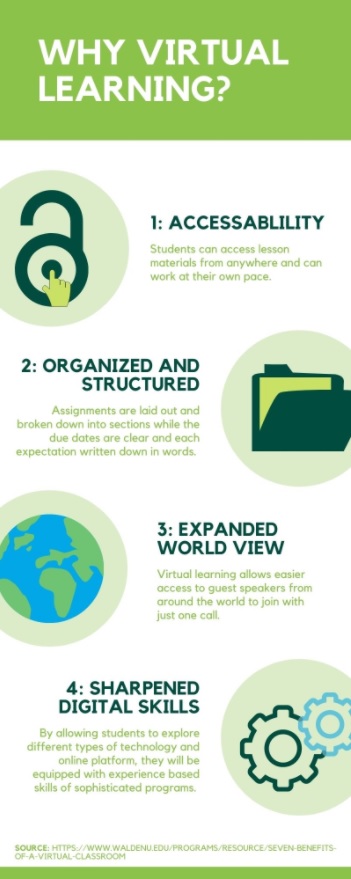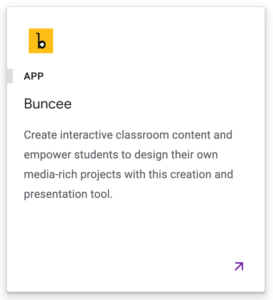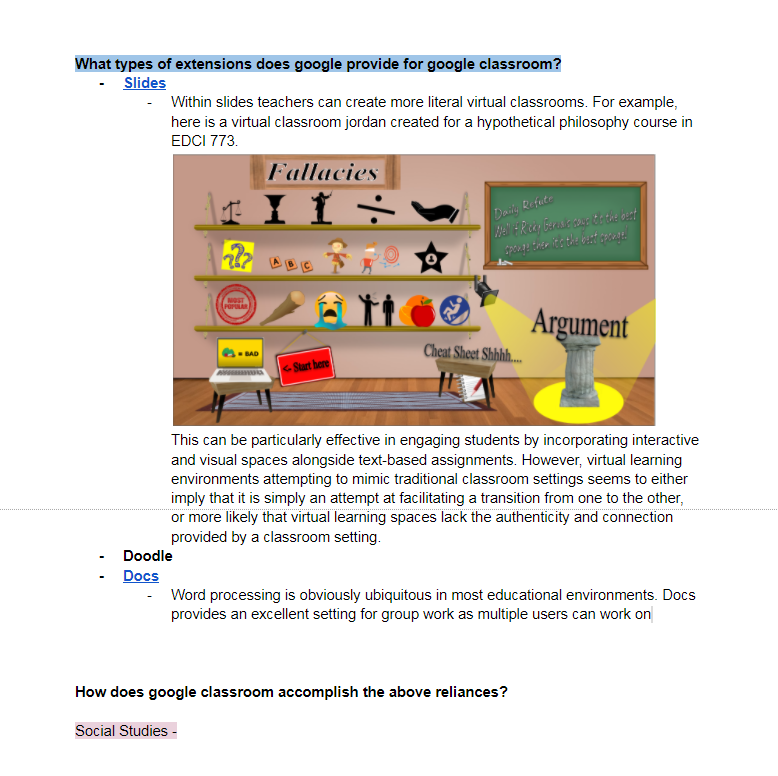Inquiry: How google classroom can be used for virtual learning in social studies and art classes.
Why is virtual learning important for our teaching and learning?
 While covid-19 has been the driving force proliferating virtual learning, it has also brought to light for many that virtual learning can be an accessible alternative to in-person instruction. Virtual learning environments (VLE) provide organization and structure to students who may not have been able to maintain that structure themselves (try not to think about our binders in middle school full of hundreds of loose papers).
While covid-19 has been the driving force proliferating virtual learning, it has also brought to light for many that virtual learning can be an accessible alternative to in-person instruction. Virtual learning environments (VLE) provide organization and structure to students who may not have been able to maintain that structure themselves (try not to think about our binders in middle school full of hundreds of loose papers).
In observations at Esquimalt high a teacher showed how her google classroom showed every assignment for the entire course from the first day of class so students could work freely; however, while this provides freedom and agency to most students, some were deeply overwhelmed by the sheer volume of tasks in front of them. With the personalization tools, she is able to specifically change what each student sees when they enter the virtual classroom so they can focus on one unit at a time.
Virtual learning provides increased opportunity for exploration by opening up classrooms past geographical location as well as providing easier access to resources. Teachers, students, guest speakers, and anyone else who would improve learning in the classroom can join in at a moment’s notice!
Digital literacy and citizenship are increasingly important areas of education. Students will most likely be asked to use technology throughout their lives and careers so familiarizing them with some basic software (that we will get into below) and understanding of computers, files, uploading, downloading, etc… can only help them on their journeys.
In the past, the internet was often seen as a space purely for fun or wasting time but real learning happened in the classroom and inside books. Obviously, that is currently not the case. The issue arises when students only engage with digital spaces for fun in video games or social media because they may not learn proper digital citizenship in protecting themselves and respecting others online. VLE’s introduce students to the fact that technology and the internet can be used productively and that safe and respectful spaces can exist online.
What does social studies education rely on?

@kylejglenn
Jennifer Hitchcock, social studies teacher of fifteen years, states that the essence of social studies education “is human interaction and [the] innate need to know the story of us then, now, and what we can be.” ( Ferlazzo 2020) This is often accomplished through direct instruction, slideshows, and is ultimately focused around research and story-telling, all easily accomplished in an online setting. However, these are just the manifest needs of social studies education, the latent needs revolve around space, authenticity, and connection.
What does art education rely on?

@justynwarner
There are many types of classes in art education, such as Art Studio, Media Arts, Studio Arts 2D, Studio Arts 3D, and Graphic Arts. Communication, thinking, personal and social are the three core competencies art education focuses on, while its main idea is the artist’s intention and how well it is communicated through art. Although the main ideas are similar, the content and types of material changes according to the different types of classes. In general, art class’s basic needs are PowerPoint presentation for lecture, teacher’s demonstration on projects, and materials.
What is google classroom?
Google classroom is a virtual learning environment provided by (shockingly) Google. To put it in fancy shmancy “I want to sell you my product” lingo, google states it helps management, measurement, and collaboration. In more general terms, it allows a virtual space for teachers to hand out assignments, resources, announcements, and allows for feedback and student interaction all while incorporating each of google’s popular softwares such as Docs or Slides.
MANAGE
Simplify teaching and learning
- Add students directly, or share a code or link so the whole class can join
- Set up a class in minutes and create class work that appear on students’ calendars
- Easily communicate with guardians and automatically send them updates
MEASURE
Move students forward
- Store frequently used feedback in your comment bank for fast, personalized responses
- Grade consistently and transparently with rubrics integrated into student work
- Enable originality reports to let students scan their own work for potential plagiarism
COLLABORATE
Strengthen student connections
- Connect with your students from anywhere with a hybrid approach for in-class and virtual classes
- Communicate important announcements to the Stream page
- Enable face-to-face connections with students using Meet built into Classroom
General use of Google Classroom.

What types of extensions are there for google classroom?
Apps from Google
Presentation tool which is the Google version of PowerPoint presentation.
Google drawings can be used as a quick annotating tool for feedback with artworks or simple mouse-drawn drawings.
Introduction to Google Drawings for teachers
Instructional video for beginners
Forms can be used for quick and easy to make and assign assessment opportunities
Word processing is obviously ubiquitous in most educational environments. Docs provides an excellent setting for group work as multiple users can work on the same project at the same time. Not to get too meta but our group is currently employing this right now!
and more…
Google approved apps from other platforms:
These apps can be used within Google classroom and are assistive tools for student engagement and staying organized online.


and more…
How does google classroom accomplish the above reliances?
Social Studies
Google classroom provides all the necessary functions of a classroom through streamlined sharing, submissions, announcements, etc… but three tool stand out as being the most effective for social studies:
- Slides – Within slides teachers can create more literal virtual classrooms. For example, here is a virtual classroom jordan created for a hypothetical philosophy course in EDCI 773.

This can be particularly effective in engaging students by incorporating interactive and visual spaces alongside text-based assignments. However, virtual learning environments attempting to mimic traditional classroom settings seems to either imply that it is simply an attempt at facilitating a transition from one to the other, or more likely that virtual learning spaces lack the authenticity and connection provided by a classroom setting. As we noted in our introduction, authenticity and connection are vital to effective social studies education.
- Docs
Of course here we need to be conscious we are not trying to solve problems we don’t need to have in the first place. While Google docs does provide more collaborative features than other software, in-person group work obviously accomplishes the same thing. However, if it is necessary to work virtually, for example if you’re in the middle of a pandemic… then it is certainly a very welcome feature. Not to get too meta but we are currently working on this assignment together over google docs right! Group-work is paramount to effective social studies learning.

- Forms
Google forms provide a quick form of assessment a teacher could even make on the fly towards the end of class. This is especially important for social studies as the class conversation will often veer in unknown directions based on the social and interconnected nature of its content.
Art
Graphic Arts and Studio Arts are considered very different in terms of material, content, and objectives. Graphic art can be taught through online courses since it’s main platform for art is online and digital; however, studio arts involves physical materials which can only be taught in a real classroom for best outcome. Anyone could and can change their lesson plans if necessary, but the main objective and the purpose of art education may disappear in the process if the planner does not consider every possible approach to satisfy class content.
In general, art class’s basic needs are powerpoint presentation for lecture, teacher’s demonstration on projects, and materials.
- Powerpoint Presentation – PPT can be made outside of the classroom and added as a file or there are Google Slides for powerpoint alternatives.
- Demonstrations – Youtube can be used and embedded onto the lesson plan and direct feedback that can be provided through Google Meet.
- Materials – Graphic Arts class can work using other platforms for access into materials, but for the Studio Art class, materials need to be prepared by the student. The projects could either be uploaded as a photo or be presented through Google Meet.
Resource for teachers in art education using google classroom:
What’s missing?
Social Studies
While videos are excellent resources to pass on to our students, it is hard to translate a meaningful story on-line and know your students were affected by it; in other words, it’s hard to read the (google class) room. Social studies, at its core, is about the social. Translating emotional and contextual knowledge is difficult to do in an online space authentically. The subtlety and nuance afforded to a live discussion or lecture that can grow, shrink, and respond to the class’s needs simply cannot be replicated in an online space like google classroom.
Some critics have levied broader complaints at googles educational platforms, claiming that the amount of information and loyalty gleamed from students using their projects from a young age is not worth the functionality google classroom provides. In her nytimes article, Natasha Singer points out that while students’ educational accounts are not subject to ads, that they are strongly encouraged (by even their teachers and administration) to transition their educational account to a personal account when they graduate, which would then be subject to google’s ad programs. It would also be difficult for students to ever seek out alternatives to google and all its tools such as Gmail, docs, slides, etc… because those programs are all they know and all they were ever provided, or even forced, to use.
The reason this is important to social studies pedagogy is that we are responsible for speaking truth to power and modelling critical thinking. The least we can do is have this exact conversation with our class, but by not providing alternatives we are implicit in these issues and cannot except our students to seek out those alternatives.
In a reddit thread debating the quality of google classroom one educator (user boyerling3) noted how googles functionality is (unsurprisingly) purposefully limited to google products. The alternative they presented was schoology. Schoology functions similarly to google classroom without being tied to one specific brand of products, while also adding improved functionality of folders, curriculum creation, and assessment (both summative and formative quizzes). However, Schoology is still a paid and rather expensive product for a school to utilize. While it offers more for a social science classroom while avoiding some of the pitfalls of google classroom, it also encounters the same issues as any paid VLE and should be viewed critically.
Art
Google Drawings is definitely not my first choice of online tools I would use for drawing; however, Drawings can be a good engagement tool for student participation. Any extensions from google allows connections between the different apps, therefore it is easier to create work that is multimodal.
The essential part of an art class is all about the hands-on experiences. Graphic design may benefit from the virtual classroom, but with art studios being the biggest part of fine arts, it can only do so much when things are completely online. Students need to be able to experience the classroom environment while working on their projects, allowing inspirations to spark between classmates.
In Conclusion…
Google classroom meets almost every logistical expectation you could hope for in an academic classroom, but in most instances we found there were actually superior alternatives to googles individual tools such as google drawing or forms, but it is googles fluid functionality and cohesive structure putting all these tools in one place that really propels it forward versus trying to use and maintain several different accounts on several different platforms and expecting your students to do the same.
Google classroom is clearly catered towards the more standard academic courses such as social studies and fails to meet all the needs of electives such as art. While this seems innocuous, it actually proves quite limiting as it prevents would-be cross-curricular exploration into those elective spaces as a matter of fact (simply unable), not as a matter of choice.
Finally, while this review has focused on critiquing google classrooms efficacy, it is certainly a very helpful software and is extremely useful as an alternative, or better yet additional (hybrid learning) tool to incorporate in our pedagogy as long as we maintain a critical lens and acknowledge we are modelling digital citizenship.
Resources
Boyerling3. Teachers of reddit, how good is Google Classroom? Reddit. https://www.reddit.com/r/Teachers/comments/5vk5en/teachers_of_reddit_how_good_is_google_classroom/.
Cains, J. T. What Is Google Classroom? https://www.dummies.com/education/internet-basics/what-is-google-classroom/.
Ferlazzo, L. (2020, May 18). Adapting Social Studies for Remote Teaching. https://blogs.edweek.org/teachers/classroom_qa_with_larry_ferlazzo/2020/05/adapting_social_studies_for_remote_teaching.html
Google. Google. https://edu.google.com/.
Morris, A. B. K. A Guide To Google Drawings For Teachers, Students, And Bloggers. The Edublogger. https://www.theedublogger.com/google-drawings/.
Schoology. Learning Management System: LMS. Schoology. https://www.schoology.com/.
Walden University. (2020, October 29). Seven-benefits-of-a-virtual-classroom. Retrieved December 05, 2020, from https://www.waldenu.edu/programs/resource/seven-benefits-of-a-virtual-classroom
Leave a Reply
You must be logged in to post a comment.